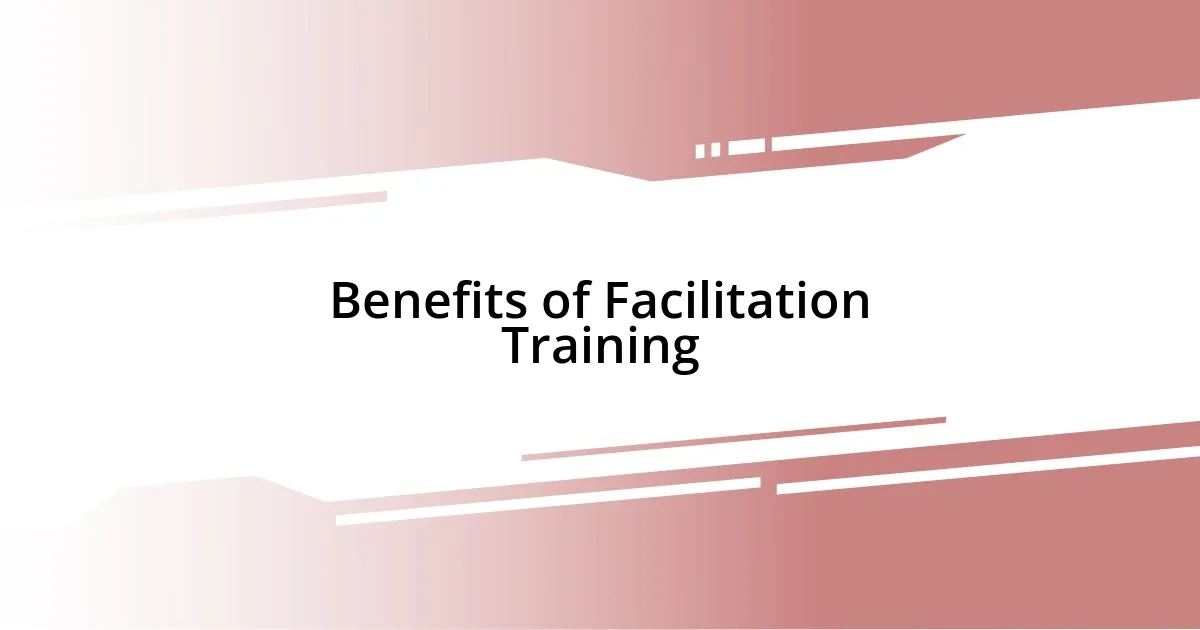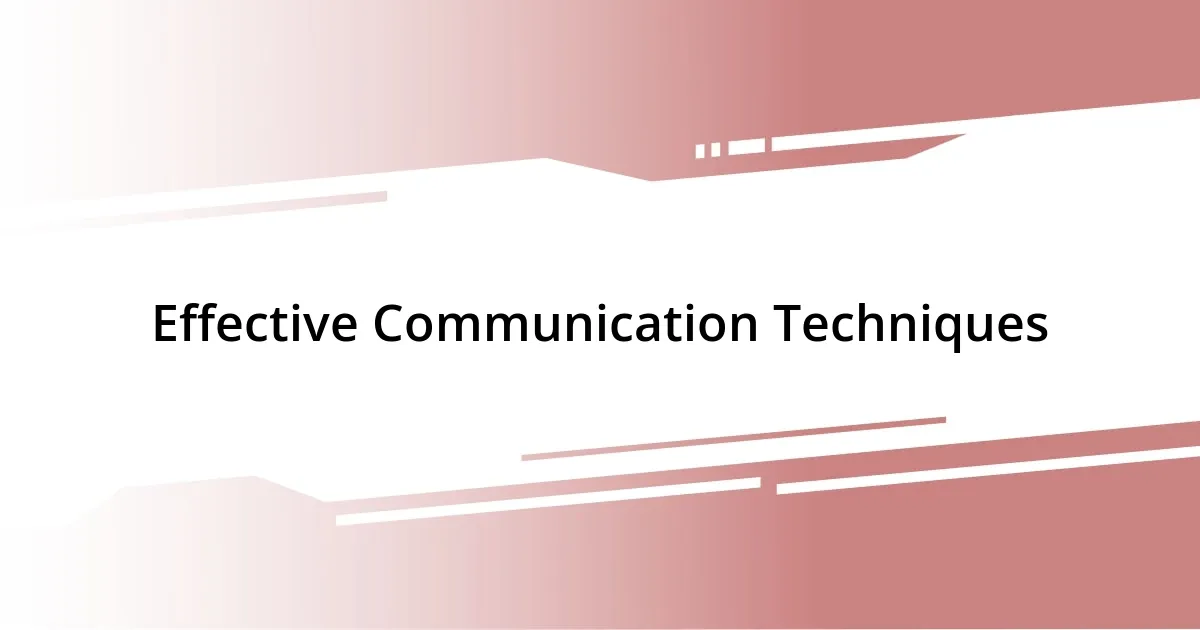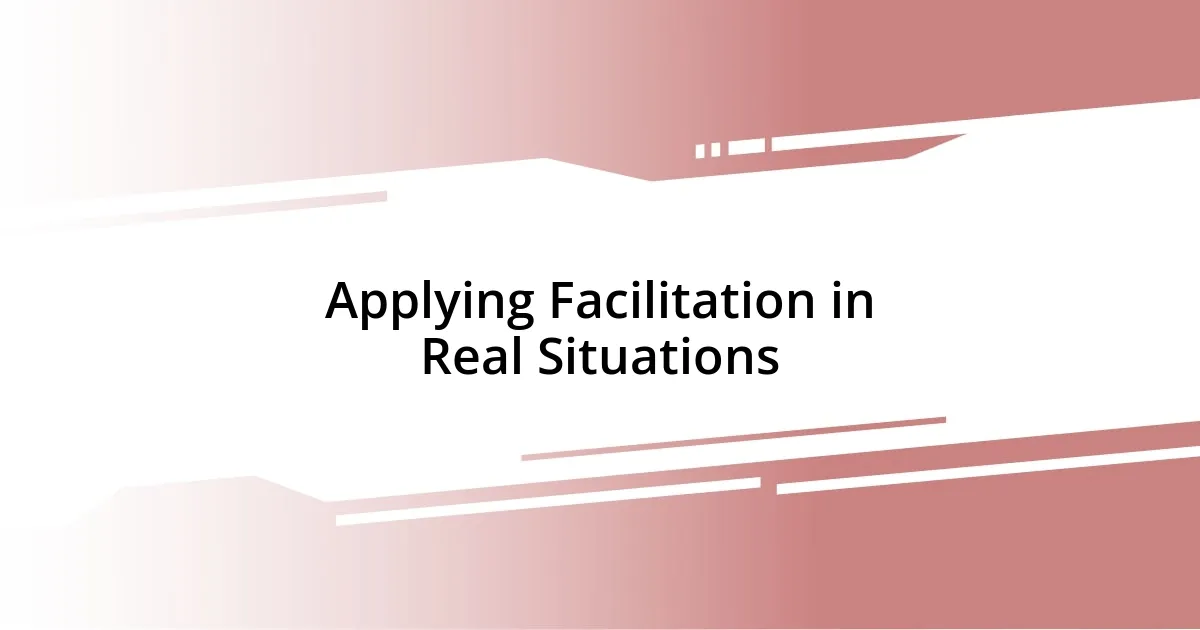Key takeaways:
- Facilitation training enhances communication and problem-solving skills, empowering facilitators to engage all participants effectively.
- Key skills acquired include active listening, conflict resolution, and managing group dynamics, which lead to more productive discussions.
- Effective communication techniques, such as using open-ended questions and being mindful of body language, create a welcoming environment for diverse participants.
- Real-world application of facilitation techniques, like the “parking lot” strategy and creative exercises, helps in managing challenging group dynamics and fosters collaboration.

Benefits of Facilitation Training
One of the most significant benefits of facilitation training is the enhancement of communication skills. I can recall a session where I struggled to get everyone involved in the discussion. After training, I discovered techniques that encouraged even the quietest members to share their thoughts. Isn’t it empowering to create a space where everyone feels their input is valued?
Facilitation training also sharpens your problem-solving abilities. I remember a challenging group decision-making task that left us spinning in circles. Through training, I learned to use specific frameworks that guided us toward consensus quickly and efficiently. Have you ever thought about how much smoother group work could be if everyone had these skills?
Moreover, completing facilitation training can boost your confidence when leading groups. I still think back to my first session post-training, where I suddenly felt like I had a toolkit to draw from. It’s astonishing how a little training can transform your mindset, isn’t it? With that newfound confidence, I was able to navigate difficult conversations and steer the group towards productive outcomes.

Key Skills Gained from Training
One of the key skills I gained from facilitation training was active listening. Before the training, I often found myself distracted during conversations, missing out on valuable insights. After focusing on this skill, I realized how much deeper the discussions became when I truly tuned in. It’s like flipping a switch; suddenly, I was connecting better with participants, and they felt more respected and heard.
Another skill that stood out to me was conflict resolution. During one of the exercises, we role-played a scenario where two team members had opposing views. At first, I found it challenging to mediate. However, using the techniques I learned, I was able to guide the conversation towards solution-building rather than confrontation. The satisfaction of bringing a tense situation to a peaceful resolution is something I will carry with me forever. Have you ever felt the thrill of resolving a conflict and witnessing the relief on everyone’s faces?
Lastly, I improved my ability to manage group dynamics effectively. I recall a moment in training when we discussed various personality types in groups. Understanding these nuances helped me adapt my facilitation style to meet different needs. This awareness turned discussions from potentially chaotic scenes to collaborative and productive exchanges. How empowering it is to help guide diverse voices toward a common goal!
| Key Skill | Description |
|---|---|
| Active Listening | Enhances connection and respect among participants, leading to deeper discussions. |
| Conflict Resolution | Transforms confrontational situations into collaborative solutions. |
| Managing Group Dynamics | Enables adaptation to various personalities for more productive exchanges. |

Effective Communication Techniques
Effective communication is at the heart of successful facilitation, and I quickly learned that the way we convey our ideas can make all the difference. For instance, during a practice session, I experimented with different tones of voice and body language, which surprisingly led to a notable change in how participants responded. It really struck me that non-verbal cues can reinforce or undermine what we say verbally. Creating an inviting atmosphere is critical—when people feel safe, they open up.
Here are some effective communication techniques I found invaluable:
- Use Open-Ended Questions: This encourages deeper discussion and allows participants to express their thoughts more fully.
- Paraphrase for Clarity: Reflecting back what someone has said not only shows that you’re listening but also clarifies any potential misunderstandings.
- Encourage Participation: Inviting quieter members to share their views can enrich the conversation and make everyone feel valued.
- Be Mindful of Tone and Body Language: A warm tone and positive body language can create a welcoming environment that boosts group engagement.
- Summarize Key Points: This not only reinforces important information but also helps everyone stay on the same page.
In another instance, I found myself in a group where tensions ran high over differing opinions. Rather than feeling overwhelmed, I remembered to apply active listening and ensure that each person’s voice was heard—this technique alleviated the stress in the room. The experience underscored for me the importance of fostering trust and respect in discussions; it’s amazing just how much a thoughtful approach can transform a challenging conversation into an opportunity for growth.

Engaging Diverse Participants
Engaging diverse participants can sometimes feel daunting, but I’ve learned that it’s all about understanding and valuing different perspectives. I remember a workshop where participants hailed from various cultural backgrounds. At first, the conversation was hesitant, but as I encouraged everyone to share their experiences, I was amazed by the wealth of insight that surfaced. Have you ever witnessed a moment when a different viewpoint illuminated a concept you thought you understood?
In one particular session, I had a participant who was quiet and reserved. I decided to use a technique I learned during training—directly inviting her to share her thoughts. What surprised me most was not only her willingness to engage but also how her contributions shifted the group’s dynamic positively. It made me realize that creating spaces for diverse voices is less about managing the conversation and more about inviting participation. Isn’t it incredible how a small gesture can transform the experience for someone?
Through my experience, I’ve come to appreciate the power of storytelling as a tool for engagement. I facilitated a discussion on challenges faced in our work environment, and as individuals began sharing their personal stories, I felt the room come alive with empathy. Each narrative brought everyone closer together, showing that while our backgrounds may differ, our core emotions are often strikingly similar. Isn’t it fascinating how stories can bridge divides and foster understanding?

Managing Group Dynamics
Managing the dynamics within a group can sometimes feel like a delicate dance. I remember sitting in a session where the energy shifted as soon as someone voiced a strong opinion. It prompted me to reflect on how reactions ripple through the group, influencing not just the discussion but also the atmosphere. Have you ever noticed how a single voice can create either tension or synergy? I realized that being attuned to these shifts is crucial for a facilitator.
During another workshop, I faced a challenge when a few participants started to dominate the conversation, leaving others feeling unseen. Instead of letting the momentum stall, I disrupted the flow by redirecting the attention back to the quieter members. I simply asked, “How do you feel about this?” What struck me was the immediate change in energy—a spark of engagement flickered in participants who had been silent. It highlighted for me that sometimes, it’s about giving space rather than filling it.
I’ve also learned that the interactions within a group can lead to unexpected connections. One time, I witnessed two participants, initially at odds about an idea, find common ground during a brainstorming break. They were both passionate about the project but had different angles. I encouraged them to collaborate, and watching their dynamic evolve was enlightening. Isn’t it amazing how discomfort can transform into a shared commitment with just a little nudge? In that moment, the group wasn’t just discussing ideas; they were building relationships, which is where the real magic happens.

Applying Facilitation in Real Situations
I often find that applying facilitation techniques in real situations requires a mix of spontaneity and structure. During a recent community meeting, I encountered an unexpected challenge when a heated debate erupted over a proposed project. Instead of letting the discussion derail, I implemented a “parking lot” technique, where off-topic issues could be noted down to address later, while we focused on the matter at hand. This simple strategy not only calmed tensions but also allowed participants to feel heard—have you ever felt the relief when a heated discussion is gracefully steered back on track?
One of my favorite experiences occurred when I introduced a creative exercise during a team strategy session. I used a method where participants drew their visions for the project, which caught everyone off guard. The laughter and surprise that ensued broke down barriers—the team members who usually sat quietly transformed into enthusiastic contributors. Isn’t it fascinating how tapping into creativity allows people to express themselves authentically? That day, I witnessed firsthand how breaking from the norm can lead to not just engagement, but genuine excitement.
In another instance, I facilitated a cross-departmental workshop where collaboration was vital. Initially, there was a noticeable divide between the teams, which led to an undercurrent of distrust. To bridge this gap, I organized a series of small group discussions where members shared a recent success story from their own departments. The more they exchanged these stories, the more I could feel the shift in atmosphere—watching them realize they were fighting for the same goals was truly uplifting. Have you ever experienced that spark of recognition when people realize they’re on the same team, despite their differences? That moment reaffirmed my belief in the power of connection through shared success.














